Household Population comprises 99.5 percent of the total population
1. As of 01 May 2020, Central Visayas has a total population of 8,081,988. Of this total, the household population comprised 99.5 percent or 8,046,285 persons. This is 2.04 million higher than the 6,008,987 household population in 2015, and 1.26 million more than the 6,785,000 household population posted in 2010. (Table A)
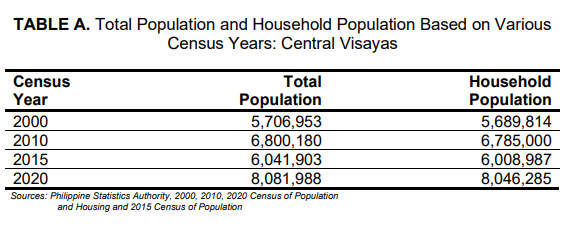
2. The remaining 0.5 percent of the total population is comprised of the institutional population or those residing in collective or institutional living quarters such as hospitals, orphanages, military camps, Filipinos in the Philippine embassies, consulates, and missions abroad.
Number of households increased by 578 thousand from 1.39 million in 2015 to 1.97 million in 2020
3. The number of households in Central Visayas reached 1,966,588 in 2020. This is higher by 578 thousand compared with the 1,388,475 in 2015 and by 478 thousand compared with 1,487,710 in 2010. (Figure 1)
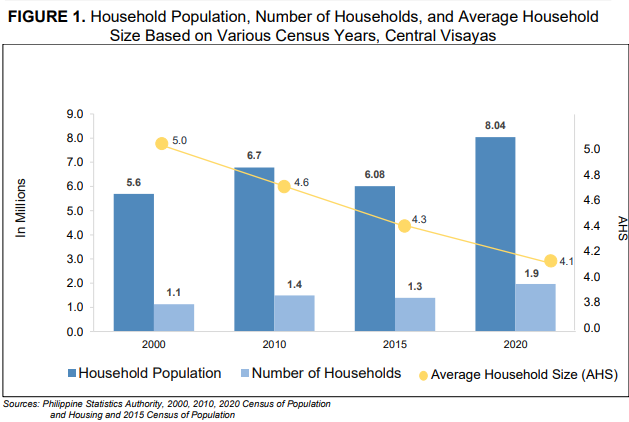
4. Among the provinces and Highly Urbanized Cities (HUCs) in Central Visayas, Cebu Province (excluding HUCs) had the most number of households in 2020 with 799 thousand, followed by the province of Negros Oriental with 347 thousand and province of Bohol with 322 thousand. The province of Siquijor posted the least number of households with 25 thousand households. (Table B)
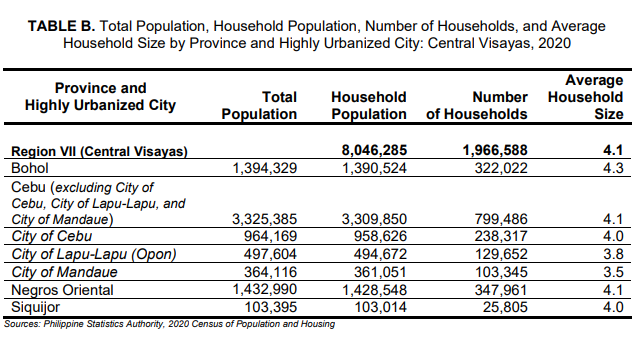
Average household size declines to 4.1 persons in 2020
5. The Average Household Size (AHS) in Central Visayas decreased from 4.3 in 2015 to 4.1 in 2020. In 2010, there were 4.6 persons, on average, per household. (Figure 1)
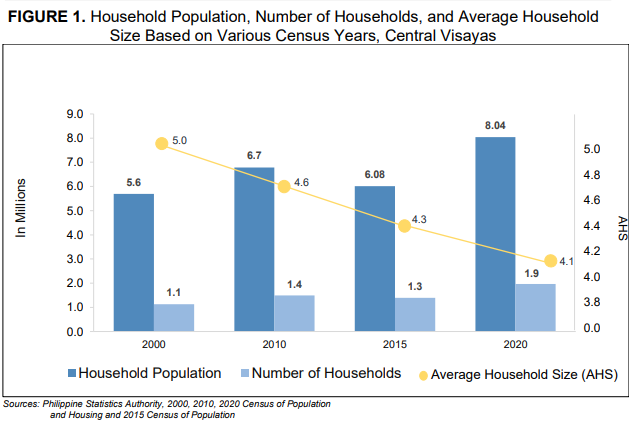
6. Among the provinces and HUCs in Central Visayas, only Bohol province posted a higher AHS of 4.3 which is higher than the regional AHS of 4.1. The provinces of Cebu (excluding City of Cebu, City of Mandaue, and City of Lapu-Lapu) and Negros Oriental posted an AHS equal to the regional level. Moreover, the HUCs and province of Siquijor posted a smaller AHS with 4.0, 3.8 and 3.5 persons, respectively. (Table 3)
Institutional population in Central Visayas reached 35,703 persons
7. As of 01 May 2020, the institutional population reached 35,703 persons, or 0.4 percent of the region’s total population of 8,081,988 persons. This figure is 1,295 persons lower than the 36,998 institutional population posted in 2015. (Figure 2)
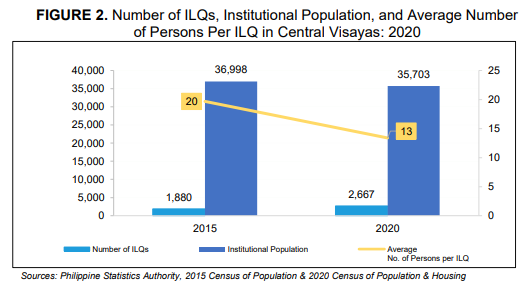
Central Visayas Urban population constitutes 51.9 percent of the total population
8. In 2020, 4.20 million or 51.9 percent of the total 8.08 million population of Central Visayas lived in urban barangays. This represents an increase of 540,011 persons from the 3.66 million urban residents in 2015. The rural population or those who lived in barangays classified as rural in 2020 comprised the remaining 3.89 million persons or 48.1 percent of the total population. (Figure 3)
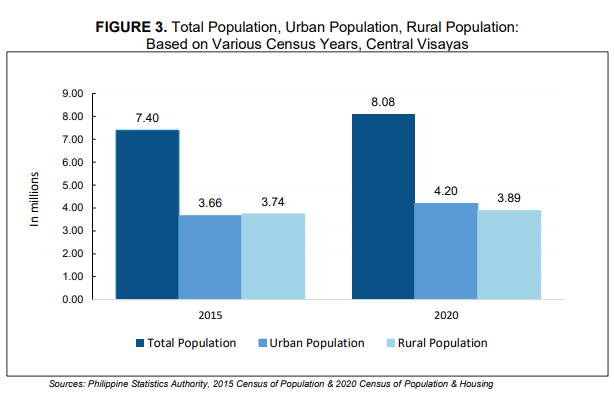
Level of Urbanization in Central Visayas, by Province and HUCs
9. Across provinces and HUCs of Central Visayas, the three highly urbanized cities were classified as mostly urban and the four provinces of Central Visayas posted a level of urbanization lower than the regional level at 51.9 percent. (Figure 4)
10. In terms of population, among the HUCs, the City of Cebu posted the biggest urban population with 908.2 thousand urban residents or a level of urbanization of 94.2 percent while the City of Mandaue posted the lowest urban population with 364.1 thousand urban residents but was classified as entirely urban with a 100 percent level of urbanization. (Figure 4)
11. Among provinces, the province of Cebu posted the biggest urban population with 1.67 million urban residents or a level of urbanization of 50.4 percent and Siquijor posted the lowest urban population with 5.5 thousand urban residents or a level of urbanization of 5.4 percent. (Figure 4)
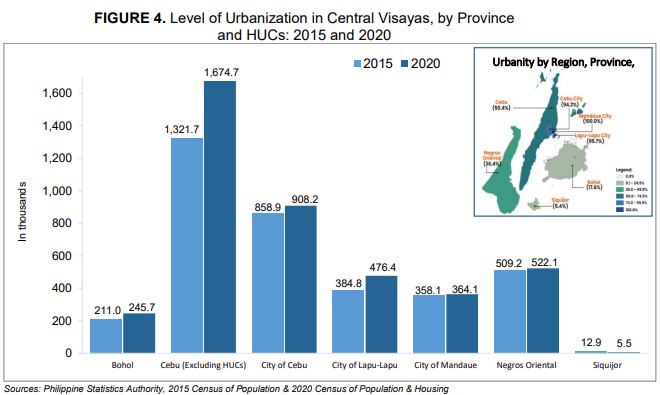
Total Number of Urban Barangays in Central Visayas by Province and HUCs
12. Among the provinces and HUCs, total number of urban barangays increased from 2015 to 2020 except for Negros Oriental and Siquijor. The urban barangays for the province of Bohol increased from 50 to 57, Cebu from 175 to 209, City of Cebu from 58 to 61, City of Lapu-Lapu from 21 to 22, and City of Mandaue from 26 to 27. While the number of urban barangays for the province of Negros Oriental decreased from 112 to 103 and Siquijor from 11 to 5 urban barangays. (Figure 5)
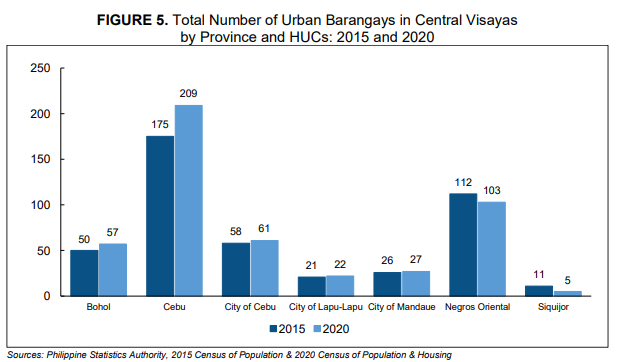
Of the 8.05 million household population, 4.08 million (50.7%) were males while 3.97 million (49.3%) were females
13. Of the 8.05 million household population in Central Visayas in 2020, 4.08 million (50.7%) were males while 3.97 million (49.3%) were females. By age group, 2.46 million (30.6%) were under 15 years of age (young dependents). (Figure 6)

14. On the other hand, persons aged 15 to 64 years (working-age or economically-active population) totaled to 5.11 million (63.5%) while those in age groups 65 years and over (old dependents) comprised the remaining 479.73 thousand (6.0%). (Figure 6)
15. Moreover, there were more males (44.7%) than females (42.3%) among the 0 to 54 age group in 2020. Meanwhile, among the older age group (55 years and over), females (7.0%) outnumbered the males (6.0%). (Figure 6)
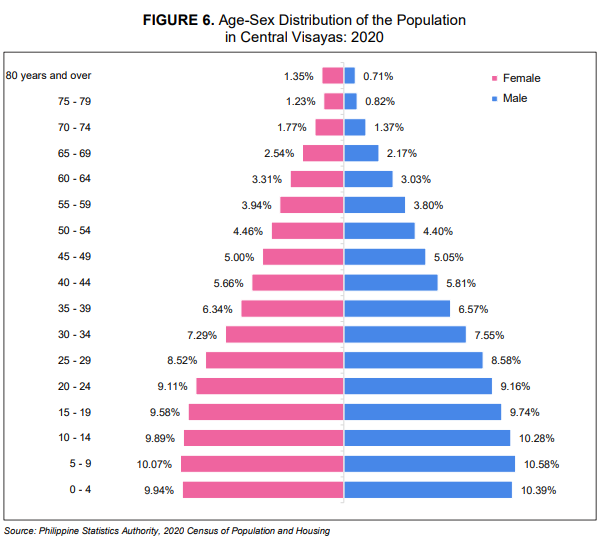
Central Visayas has a total birth registration of 7.89 million or 7,894,804 persons
16. Central Visayas has a total birth registration of 7.89 million or 7,894,804 persons or 98% of its total population and 95% or 7.70 million (or 7,699,464) persons has a copy of their birth certificate. (Figure 7)
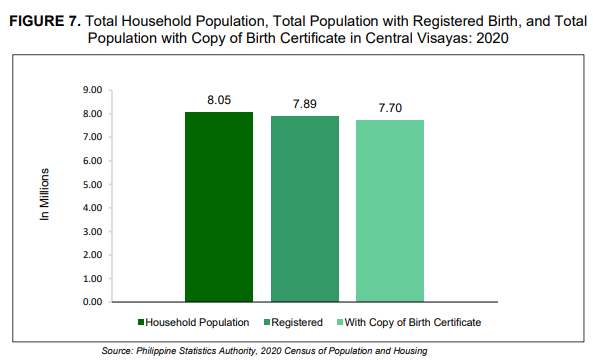
17. In terms of the proportion of persons with registered births in Central Visayas, Siquijor recorded the highest birth registrations at 99.4 percent followed by City of Mandaue at 98.9 percent. Among the 4 provinces and 3 HUCs in Central Visayas, the province of Siquijor, Bohol, Cebu, the City of Mandaue and City of Cebu posted a proportion of registered births higher than the regional level of 98.1percent. (Figure 8)
18. Negros Oriental posted the lowest proportion of persons with registered births, with only 97.1 percent of the household population. This corresponds to 91 persons in the province who were reported to have not registered their births. (Figure 8)

Of the 7,228,144 household population five years old and over in Central Visayas, 8 in every 100 persons had at least one domain of functional difficulty
19. Of the 7,228,144 household population five years old and over in Central Visayas, 8 in every 100 persons had at least one domain of functional difficulty, that is any of the six functional domains of seeing, hearing, walking or climbing steps, remembering or concentrating, self-caring (washing all over or dressing) or communicating. Based on the 2020 Census of Population and Housing (2020 CPH), 575,242 persons five years old and over reported to have difficulty in functioning in at least one of the said six domains in Central Visayas. (Figure 9)

20. Of the 575,242 household population aged five years and over with at least one domain of functional difficulty in Central Visayas in 2020, 71.3 percent or 409,749 persons reported having difficulty seeing, even when wearing glasses. Moreover, those with difficulty in walking or climbing steps comprised 26.9 percent or 154,791 persons. Persons with difficulty in hearing even when using a hearing aid comprised 24.2 percent or 139,290. Difficulty in remembering or concentrating comprised 22 percent or 126,683 persons and Persons who have difficulty in self-caring and communicating using their usual (customary) language comprised the lowest percentage of about 9 percent of the total household population aged five years and over with at least one domain of functional difficulty. (Figure 10)
21. Details of functional difficulty by domain do not add up to the aggregate household population five years old and over with at least one domain of functional difficulty due to persons with multiple functional difficulties. (Figure 10)

Technical Notes
The Philippine Statistics Authority (PSA) conducted the 2020 Census of Population and Housing (CPH) in September 2020. The 2020 CPH was a nationwide government undertaking that involved the collection, compilation, evaluation, analysis, publication, and dissemination of data on population count, demographic and socio-economic characteristics of the population, housing characteristics, household characteristics, and barangay characteristics in each barangay, city/municipality, province, and region in the country. With reference to the first census in 193, the 2020 CPH was the 15th census of population and the 7th census of housing in the Philippines.
The 2020 CPH was undertaken by the PSA pursuant to Republic Act No. 10625, also known as the Philippine Statistical Act of 2013, Executive Order No. 352 – Designation of statistical activities that will generate Critical Data for Decision-Making of the Government and the Private Sector, and Batas Pambansa (BP) Bilang 72, which provide the basis for the decennial conduct of the integrated census of population and housing.
Information on the count of the population were collected with 12:01 a.m. of 1 May 2020 as the census reference time and date.
Most of the operational concepts and definitions adopted in the 2020 CPH have also been used in the past censuses of population and housing. The use of standard operational definitions of terms and concepts and adherence to national and international standard classifications were aimed at ensuring the comparability of census results across different census years and census data of other countries.
A household is a social unit consisting of a person living alone or a group of persons who sleep in the same housing unit and have a common arrangement in the preparation and consumption of food.
Household population comprises of persons who belong to a household. In determining household membership, the basic criterion is the usual place of residence or the place where the person usually resides. This may be the same or different from the place where he/she is found at the time of the census. As a rule, it is the place where he/she usually sleeps.
Institutional living quarter (ILQ) is a structurally separate and independent place of abode intended for habitation by large groups of individuals. Such a quarter usually has certain common facilities such as kitchen and dining room, toilet and bath, and lounging area which are shared by the occupants.
Institutional population comprises of persons who are found living in institutional living quarters (ILQs). They may have their own families or households elsewhere but at the time of the census, they are committed or confined in institutions, or they live in ILQs and are usually subject to a common authority or management, or are bound by either a common public objective or a common personal interest.
Average household size (AHS) is a measure obtained by dividing the number of persons in households by the number of households.
His Excellency President Rodrigo R. Duterte declared as official for all purposes the population counts by province, city/municipality, and barangay, based on the 2020 CPH under Proclamation No. 1179 dated 6 July 2021.
Approved by:
(SGD.) ARIEL E. FLORENDO
Regional Director

